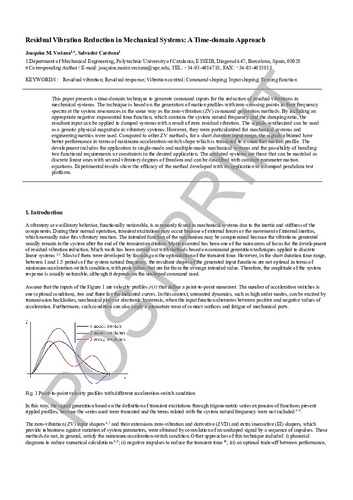Mostra el registre d'ítem simple
Residual vibration reduction in mechanical systems: a time-domain approach
| dc.contributor.author | Veciana Fontanet, Joaquim Maria |
| dc.contributor.author | Cardona Foix, Salvador |
| dc.contributor.other | Universitat Politècnica de Catalunya. Departament d'Enginyeria Mecànica |
| dc.date.accessioned | 2012-07-24T11:15:47Z |
| dc.date.created | 2012-08 |
| dc.date.issued | 2012-08 |
| dc.identifier.citation | Veciana, J. M.; Cardona, S. Residual vibration reduction in mechanical systems: a time-domain approach. "International Journal of Precision Engineering and Manufacturing", Agost 2012, vol. 13, núm. 8, p. 1327-1339. |
| dc.identifier.issn | 2234-7593 |
| dc.identifier.uri | http://hdl.handle.net/2117/16317 |
| dc.description.abstract | This paper presents a time-domain technique to generate command inputs for the reduction of residual vibrations in mechanical systems. The technique is based on the generation of motion profiles with zero-crossing points in their frequency spectra at the system resonances in the same way as the zero-vibration (ZV) command generation methods. By including an appropriate negative exponential time function, which contains the system natural frequency and the damping ratio, the resultant input can be applied to damped systems with a result of zero residual vibration. The signals synthesized can be used as a generic physical magnitude in vibratory systems. However, they were particularized for mechanical systems and engineering metrics were used. Compared to other ZV methods, for a short duration input range, the signals obtained have better performance in terms of minimum-acceleration-switch shape which is translated to a smoother motion profile. The development includes the application to single-mode and multiple-mode mechanical systems and the possibility of handling two functional requirements or constraints in the desired application. The analyzed systems are those that can be modeled as discrete linear ones with several vibratory degrees of freedom and can be described with constant parameter motion equations. Experimental results show the efficacy of the method developed with its application to a damped pendulum test platform. |
| dc.format.extent | 13 p. |
| dc.language.iso | eng |
| dc.publisher | Springer |
| dc.rights | Attribution-NonCommercial-NoDerivs 3.0 Spain |
| dc.rights.uri | http://creativecommons.org/licenses/by-nc-nd/3.0/es/ |
| dc.subject | Àrees temàtiques de la UPC::Enginyeria mecànica::Mecànica::Vibracions mecàniques |
| dc.subject.lcsh | Vibration--Control |
| dc.title | Residual vibration reduction in mechanical systems: a time-domain approach |
| dc.type | Article |
| dc.subject.lemac | Vibracions |
| dc.contributor.group | Universitat Politècnica de Catalunya. GREVTAM - Grup de Recerca en Vibracions i Teoria i Anàlisis de Màquines |
| dc.identifier.doi | 10.1007/s12541-012-0176-2 |
| dc.relation.publisherversion | http://www.springerlink.com/content/g204728p12w82315/ |
| dc.rights.access | Open Access |
| local.identifier.drac | 10681906 |
| dc.description.version | Postprint (published version) |
| dc.date.lift | 10000-01-01 |
| local.citation.author | Veciana, J. M.; Cardona, S. |
| local.citation.publicationName | International Journal of Precision Engineering and Manufacturing |
| local.citation.volume | 13 |
| local.citation.number | 8 |
| local.citation.startingPage | 1327 |
| local.citation.endingPage | 1339 |
Fitxers d'aquest items
Aquest ítem apareix a les col·leccions següents
-
Articles de revista [596]
-
Articles de revista [21]


